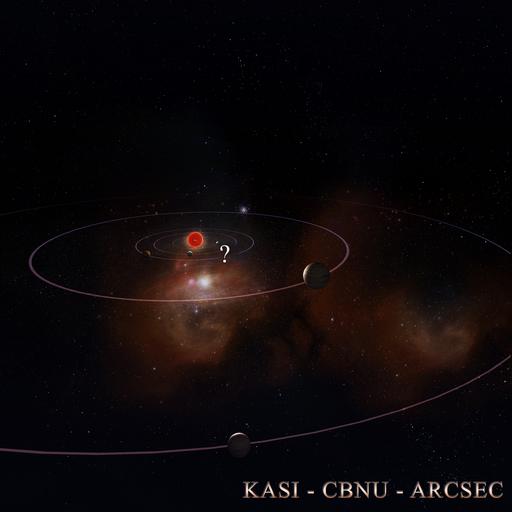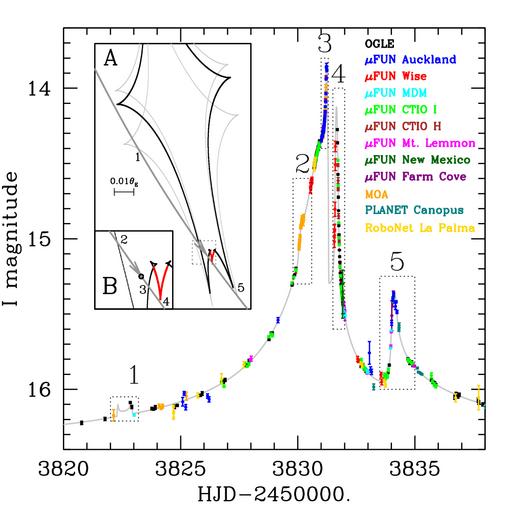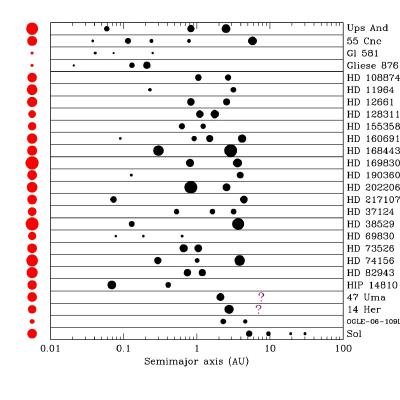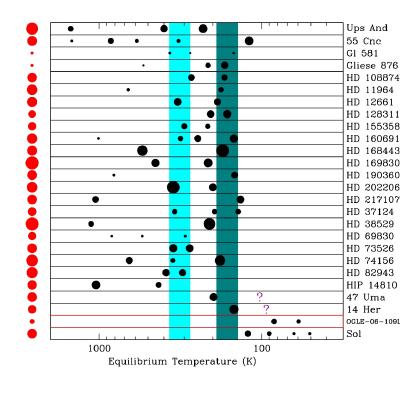MicroFUN - MicroLensing Follow-Up Network
Discovery of a Jupiter/Saturn Analog in OGLE-2006-BLG-109
The
MicroFUN Collaboration, in conjunction
with the
OGLE,
MOA, and
PLANET/RoboNet Collaborations, have
discovered a planetary system that looks a lot like our own solar
system. Our data reveal planets orbiting a star ~5000 light years away
that resemble smaller versions of Jupiter and Saturn. The star is
smaller, cooler, and dimmer than our Sun, but the planets are also
smaller than Jupiter and Saturn, and are closer to their parent star.
Even so, the entire system looks like a scaled-down version of our solar
system.

Artist's conception of the OGLE-2006-BLG-109 planetary system.
[Full Resolution (2Mb JPEG)]
We also know that there are no other gas giant planets in this system,
but there may well be planets closer to the star similar to own own
Mercury, Venus, Earth, and Mars. There may also be more lower mass ice
giants, reminiscent of Uranus and Neptune.
These are the fourth and fifth planets discovered using the microlensing
technique, and the third and fourth found by the MicroFUN collaboration,
the others being OGLE-2005-BLG-071, a
Jupiter-mass planet announced in May 2005, and OGLE-2005-BLG-169, a Neptune-Mass
"Super-Earth" Planet.
Interestingly, this is the first time that we've detected a giant
planet with microlensing where we had high sensitivity to a
Saturn-like planet. The fact that we did detect a second gas giant,
may mean solar systems like our own are common throughout the Galaxy.
Technical Details
The microlensing method works by using the gravity of the star and its
orbiting planets as a lens,
bending
and
magnifying
the light from a background star.
By measuring and studying how the complex patterns of the magnified
background light change as the planetary system passes in front of the
background star, we can determine the properties of the planets and
their star. The 'light curve' of the brightness variations of
OGLE-2006-BLG-109 is shown below, and is composed of data from 11
different observing sites located around the world from the OGLE,
MicroFUN, MOA, and PLANET/RoboNet collaborations.

- Light Curve of OGLE-2006-BLG-109 composed of data from
the OGLE, MicroFUN, and PLANET/RoboNet sites.
[Full Resolution (453k JPEG)]
For this system, we were able to use subtleties in the microlensing
brightness variations to infer a surprisingly large amount of
information about the star and its planets. The star is half a solar
mass and the planets are 70% of Jupiter's mass and 90% of Saturn's mass,
respectively.
Implications for the Frequency of Solar System Analogs
Before the initial discovery of extra-solar planets orbiting normal
stars in 1995, it was thought that most solar systems should resemble
our own. However, very few of the planetary systems found so far look
anything like our solar system.
"The known multi-planet systems are shown below; these systems tend to have
gas giant planets that are much closer to their parent stars than the giant
planets in our solar system, and so have much higher temperatures.
-
- Gallery of known multiple-planet systems, including our
own system (bottom row) and the planetary system orbiting
OGLE-2006-BLG-109L (2nd row from the bottom).
- Left: Planetary systems arranged by distance from
their parent star (orbital semi-major axis) in AU.
- Right: Same systems as at right, but now plotting the
equilibrium temperatures of the planets for their parent stars. Blue
indicates the zone of liquid water, dark blue indicates the "snow line"
beyond which ices can form.
We are now developing the sensitivity to find planetary systems like our
own, and our discovery suggests that perhaps the initial predictions
actually got it mostly right: while some planetary systems look nothing
like ours, those that do may actually be quite common.
- Discovery Paper in Science
- Gaudi et al. 2008, Science, 319, 927-930 (Abstract only).
- Preprint on arXiv.org:
- arXiv:0802.1920 (full text)
- Press Releases:
- The Ohio State
University (US)
- University of Notre Dame (US)
- National Science Foundation (US)
- Massey University (New Zealand)
- Dartmouth
College (US)
- Science & Technology Facilities Council (UK)
- Press Coverage:
- The New York Times (US)
- Washington Post (US)
- Associated Press (US)
- TV NZ (New Zealand)
- New Zealand Herald (New Zealand)
- Nature News (UK)
- Chosun Ilbo (South Korea)
- The Jerusalem Post (Israel)
- Astronomia.pl (Poland)
- The Sidney Morning Herald (Australia)
- National Geographic News (US)
- Pravda (Russia)
- The Korea Times (South Korea)
- Xinhua (China)




